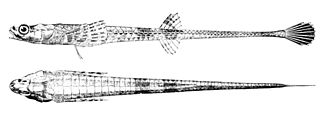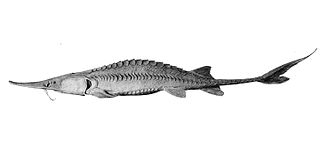
Cod is the common name for the demersal fish genus Gadus, belonging to the family Gadidae. Cod is also used as part of the common name for a number of other fish species, and one species that belongs to genus Gadus is commonly not called cod.

Mackerel is a common name applied to a number of different species of pelagic fish, mostly from the family Scombridae. They are found in both temperate and tropical seas, mostly living along the coast or offshore in the oceanic environment.

Pollock or pollack is the common name used for either of the two species of North Atlantic marine fish in the genus Pollachius. Pollachius pollachius is referred to as pollock in North America, Ireland and the United Kingdom, while Pollachius virens is usually known as saithe or coley in Great Britain and Ireland. Other names for P. pollachius include the Atlantic pollock, European pollock, lieu jaune, and lythe; while P. virens is also known as Boston blue, silver bill, or saithe.

The Percidae are a family of ray-finned fish, part of the order Perciformes, which are found in fresh and brackish waters of the Northern Hemisphere. The majority are Nearctic, but there are also Palearctic species. The family contains more than 200 species in 11 genera. The perches, and their relatives are in this family; well-known species include the walleye, sauger, ruffe, and three species of perch. However, small fish known as darters are also a part of this family.

Herring are forage fish, mostly belonging to the family of Clupeidae.

"Sardine" and "pilchard" are common names for various species of small, oily forage fish in the herring family Clupeidae. The term "sardine" was first used in English during the early 15th century, a folk etymology says it comes from the Italian island of Sardinia, around which sardines were once supposedly abundant.

Carcharhiniformes, the ground sharks, are the largest order of sharks, with over 270 species. They include a number of common types, such as catsharks, swellsharks, and the sandbar shark.

The Squaliformes are an order of sharks that includes about 126 species in seven families.

The poachers are a family (Agonidae) of small, bottom-dwelling, cold-water marine fish. They are also known as Irish lords, sea ravens, alligatorfishes, starsnouts, hooknoses, and rockheads. Poachers are notable for having elongated bodies covered by scales modified into bony plates, and for using their large pectoral fins to move in short bursts. The family includes about 59 species in some 25 genera, some of which are quite widespread.

The flagtails are a family (Kuhliidae) of perciform fish of the Indo-Pacific area. The family consists of several species in one genus, Kuhlia. Most are euryhaline and often found in brackish water, but the genus also includes species restricted to marine or fresh water.

Arowanas are freshwater bony fish of the subfamily Osteoglossinae, also known as bony tongues. In this family of fish, the head is bony and the elongated body is covered by large, heavy scales, with a mosaic pattern of canals. The dorsal and anal fins have soft rays and are long based, while the pectoral and ventral fins are small. The name "bonytongues" is derived from a toothed bone on the floor of the mouth, the "tongue", equipped with teeth that bite against teeth on the roof of the mouth. The arowana is a facultative air breather and can obtain oxygen from air by sucking it into its swim bladder, which is lined with capillaries like lung tissue.

Sprat is the common name applied to a group of forage fish belonging to the genus Sprattus in the family Clupeidae. The term also is applied to a number of other small sprat-like forage fish. Like most forage fishes, sprats are highly active, small, oily fish. They travel in large schools with other fish and swim continuously throughout the day.

Thunnus is a genus of ocean-dwelling, ray-finned bony fish from the mackerel family, Scombridae. More specifically, Thunnus is one of five genera which make up the tribe Thunnini – a tribe that is collectively known as the tunas. Also called the true tunas or real tunas, Thunnus consists of eight species of tuna, divided into two subgenera.

Scaphirhynchus is a genus of sturgeons native to the United States of America. All species in this genus are considered to be threatened. The pallid sturgeon is Endangered and the Alabama sturgeon is Critically Endangered.
Alligatorfish may refer to one of two species:

Semiplotus is a genus of cyprinid fishes found in south Asia.
Anoplagonus is a genus of poachers native to the northern Pacific Ocean.

The Alligatorfish is a fish in the family Agonidae (poachers). It was described by Marcus Elieser Bloch in 1786. It is a marine, temperate water-dwelling fish which is known from the northwestern Atlantic Ocean, including western Greenland; Labrador, Canada; and Cape Cod, Massachusetts, USA. It dwells at a depth range of 0–695 metres, most often around 60–150 m, and inhabits sand and mud bottoms mostly on the lower continental shelf all year. It prefers a temperature range of -1.07 to 2.52 °C. Males can reach a maximum total length of 22 centimetres, but more commonly reach a TL of 14.2 cm.
The Arctic alligatorfish is a fish in the family Agonidae (poachers). It was described by C.F. Lütken in 1877. It is a marine and brackish-water dwelling fish which is known from the Arctic, the northwestern Atlantic and northwestern and northeastern Pacific Ocean, including Canada, Greenland, Siberia, the Barents Sea, the White Sea, the Kara Sea, the Chukchi Sea, the Bering Sea, the Bering Strait, and the Anadyr Gulf. It dwells at a depth range of 7–520 metres, in salinities of 30-35 ppt, and leads a benthic lifestyle, inhabiting sand and mud bottoms. It mostly lives in temperatures below 0 °C, but on rare occasions has been found in temperatures of 2-3 °C. Males can reach a maximum total length of 8.6 centimetres.
Anoplagoninae is a subfamily of marine ray-finned fishes belonging to the family Agonidae, part of the sculpin superfamily Cottoidea. These fishes are found in the North Pacific Ocean.















